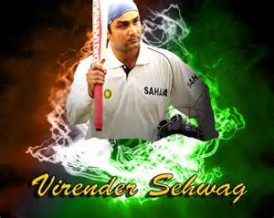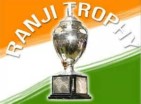Modern Era’s Most Destructive Batsmen:Virender Sehwag and his Greatest Contemporaries
Gautam Lalotra |
Whenever a cricketing great hangs up his boots, it opens up a big debate among the pundits, critics and the fans to judge him with his peers or contemporaries. The comparisons are often drawn on the basis of their style of batting, approach to the game and the role they played as a batsman for their respective sides. The likes of Sachin Tendulkar shall always draw comparisons with fellow legends like Brian Lara and Ricky Ponting who would be hailed as the modern era batting greats owing to their brilliant stroke play and a certain degree of flair and flamboyance they brought to their batting. Similarly Jacques Kallis, Rahul Dravid and Kumara Sangakkara would go down as the finest technicians of the game who stood rock solid in accumulating runs in test of times, thereby being christened as “Mr. Dependables” of their respective teams. But when it comes to Virender Sehwag, it was his attacking prowess and match winning ability which came to the fore and had a timeless impact on the game of cricket. So it is but natural to draw comparisons with batsmen who played their cricket in the same brand and style as Sehwag did. In my opinion to which most would draw consensus, there are four batsmen who come closest to Sehwag when it comes to being the most destructive batsmen over the last two decades. Sanath Jayasuriya, Adam Gilchrist, Brendon McCullum and Chris Gayle in every sense are Sehwag’s greatest rivals who could push for a case for being the most devastating batsman in an era where Sehwag bloomed and prospered and became India’s greatest match winner with the bat.
There are many a batsmen who could be clubbed in the same league as Sehwag, but I have shortlisted only four of them as they had a highly successful career playing an aggressive brand of cricket and produced match winning knocks on a consistent basis for their national sides for over a sustained period of time.
If we go down in time, Sir. Vivian Richards should be credited for giving the game an attacking dimension to batting. Richards tore apart the best of bowling attacks with relative ease. Richards made his presence felt with an imposing persona and athletic frame. Viv Richards gave batting a breath of fresh air when a defensive mind set largely loomed over most of the prolific run scorers who epitomized the old school of playing the Gentleman’s game. Richards broke the shackles and took on the best bowlers of his generation with an approach to dominate them. Richards created a fear of his own through his swashbuckling style of batting and ended up scoring 8540 test runs for the West Indies at a staggering strike rate of a touch above 70, which was a distant dream for most batsmen in that period. He was equally menacing in ODI cricket where he amassed 6721 runs at an average of 47 with a sensational strike rate of 90 which put him miles ahead of his nearest rival.
VIRENDER SEHWAG – INDIA’s MOST DESTRUCTIVE OPENING BATSMAN
In an era where the openers were told to see of the new ball, present a text book technique and play in the so called V, Virender Sehwag gave a new dimension to opening in test matches. Sehwag had a simple method to his batting, “See the ball and Hit the ball”. Sehwag had a unique approach to batting which was a perfect recipe of hand eye coordination and sublime timing. Sehwag had a stiff challenge of facing the new cherry in hostile overseas conditions and negotiating the pace and swing of the best bowling attacks in the world. In a career spanning more than a decade as a test and ODI opener, its creditable for Sehwag to maintain an outstanding average of almost 50 all through his career combined with a brilliant strike rate of 82 in the longer form of the game. Sehwag’s attacking stroke play turned out to be the key differentiator in India’s ability to win matches from situations which at best could have ended in dead draws. Viru was a touch more consistent than his contemporaries in his ability to score big hundreds. His 14 centuries of 150+ runs is testimony to this fact. Among batsmen who adopted his aggressive style, he has two triple centuries to his name, a feat only matched by the Big Jamaican Chris Gayle. Sehwag has the record for scoring the fastest triple test century in just 278 balls against South Africa at Chennai. Sehwag’s game was ideally suited to the limited overs format where he gave flying starts to the Indian team courtesy his lethal array of shot making. Sehwag formed successful combinations with Sachin Tendulkar, Saurav Ganguly and Gautam Gambhir over his career to lay a strong foundation for the Indian team. Sehwag has the unique distinction of scoring a double ton in limited overs cricket, joining an elite band of batsmen which includes Indian batting legend Sachin Tendulkar and Rohit Sharma.
Virender Sehwag International Cricket Record
Tests – 104 Runs 8586 Average 49.34 Strike Rate 82.23
ODI’s – 251 Runs 8273 Average 35.05 Strike Rate 104.33
T-20s: Strike Rate 147.83, 100s 2
SEHWAG’S GREATEST CONTEMPORARIES AND CONTENDERS FOR THE MOST DESTRUCTIVE BATSMAN IN HIS ERA
1. SANATH JAYASURIYA
The 90’s saw the concept of pinch hitting being introduced to world cricket. First it was Mark Greatbatch and Ken Rutherford who had limited success for the Kiwis at the 1992 World Cup played Down Under. Sri Lanka’s astute leader and captain Arjuna Ranatunga then took a big gamble by promoting Sanath Jayasuriya and Romesh Kaluwitharana as pinch hitters up the order and the uncanny move paid off huge dividends in the 1996 World Cup. Sanath Jayasuriya burst onto the international scene with his explosive batting and became a sensation in the 1996 World Cup. Jayasuriya became a great exponent of the pull and cut shot and scored boundaries at will off good length deliveries. Sanath derived all his power from a low center of gravity and iron like forearms. Jayasuriya made maximum use of the fielding restrictions and chipped and lobbed the red cherry over the in-field to propel Sri Lanka’s scoring rate in the first 15 overs. Sanath also produced some fireworks in the test arena and his devastating knock of 340 against India would stand the test of time.
Sanath perhaps lost out to Sehwag in putting up impressive career numbers as he started off his career as a main stream opener only after 80 odd games in the ODI’s before which he batted lower down the order and was used more as a left arm bowler. Sanath shall go down as the most destructive batsman the Island nation has produced in its cricketing history.
Sanath Jayasuriya International Record
Tests – 110 Runs 6973 Average 40.07 Strike Rate 65.1
ODIs – 445 Runs 13430 Average 32.36 Strike Rate 91.20
T-20 Strike Rate 140.08 100s:1
2. ADAM GILCHRIST
Adam Gilchrist would be best remembered for revolutionizing the concept of wicketkeeper batsman in international cricket. Adam Gilchrist was the most destructive wicketkeeper batsman to ever play the game. Gilchrist tore apart the best of bowling attacks by scoring at an alarming pace with fellow Australian opener Matthew Hayden in limited overs cricket. Gilly had all the shots in his batting arsenal and combined sublime timing with excellent hand eye coordination to destroy the best bowling attack on his day. One of the most feared openers of his generation, Gilchrist produced some breath taking innings in big matches and gave the Australians the much required impetus up the order in all the three World Cup finals (1999-2007) they won. Gilchrist has been hailed as the most lethal batsman to bat at number seven in test cricket.
Adam turned around the fortunes of many test matches in just a session by plundering the bowlers to all sides of the park, thereby demoralizing the opposition’s spirits. Gilchrist smashed a 57 ball century against England which is the fastest century by an Australian in test cricket. Gilchrist’s big hitting is certified by the fact that he became the first batsman to score 100 sixes in test matches. However critics often citied that he came down the batting order and had to build on an already strong platform laid by the impeccable Australian batting line up of their golden era, hence never got exposed to top quality bowling upfront. Gilchrist also had his set of problems against in-swinging deliveries and the 2005 Ashes series exposed this weakness of his game. Nevertheless Adam Gilchrist shall always be remembered as a swashbuckling batsman in modern day cricket who played his game in a fearless manner
Adam Gilchrist International Cricket Record
Tests – 96 Runs 5570 Average: 47.6 Strike Rate 81.95
ODI’s – 287 Runs 9619 Average: 35.89 Strike Rate:96.94
T-20 Strike Rate: 140.28 100s:3
3. CHRIS GAYLE
When it comes to sheer power of hitting the ball, there could be none better than Chris Gayle. The tall and powerful Jamaican has carved a niche for himself in the cricketing fraternity for his sheer brutal assault on bowling attacks all over the world. Gayle’s bludgeoning stroke play has come to great effect in the T-20 format where he has been very consistent in producing some scintillating display of power hitting for his franchises in club cricket and his national team. His sensational knock of 175* vs Pune Warriors in the IPL is one of a kind the cricketing fraternity has ever witnessed. His 17 rapid fire centuries in T-20 cricket makes him the runaway leader from the pack. Gayle is best known for hitting towering sixes which showcases his immense strength and bat speed he generates through his back lift. There is no ground in this world big enough to curb the “Gayle Storm” when it strikes the opponent. Gayle has been at his attacking best in the ODI format but at times has been wanting for his consistency.It comes as no surprise that Gayle has the fastest ODI double hundred to his name courtesy that whirlwind knock of 215 he scored against Zimbabwe in the 2015 World Cup. Gayle has also smashed the maximum sixes (16) in an ODI innings, a record he jointly holds with Rohit Sharma and AB De Villiers. Gayle’s record in test cricket is pretty decent for the way he bats and to the big man’s credit,he has scored two triple centuries. Gayle had his set of injury problems and his on an off standoff with the West Indies Cricket Board has certainly affected his international career. So in a nutshell Gayle could be considered as the most lethal batsman in T-20 format, but loses out to Sehwag in the test arena where he has witnessed somewhat a sea saw kind of a career.
Chris Gayle International Cricket Record
Tests – 103 Runs 7214 Average: 42.18 Strike Rate: 60.26
ODI‘s – 269 Runs:9221 Average: 37.33 Strike Rate: 85.11
T-20s: SR: 149.95, 100’s:17
4. BRENDON McCULLUM
Kiwi demolition man Brendon McCullum had a sledge hammer approach to his batting which resulted in some serious damage done to the best of bowling attacks all over the world. Brendon went after anything which was in his slot to hit. ”Baz” usually stepped down the crease to slog any short delivery over the boundary. Brendon relied on his cheeky yet innovative stroke play, lightning quick footwork and brute power to decimate the best attacks in the world. He had a 360 approach to batting which made it very difficult for any opposition to set a field. Brendon’s attacking prowess was mainly confined to the ODI and T-20 format although he developed into a very combative batsman for the Kiwis in the longer format in the later half of his career.McCullum smashed the fastest test century when he decimated the Australians by scoring a 54 ball century at Christchurch.
Brendon McCullum International Record
Tests – 101 Runs 6453 Average 38.64 Strike Rate 64.6
ODI’s – 260 Runs 6083 Average 30.41 Strike Rate 96.37
T-20s Strike Rate 137.34, 100s 7
Shahid Afridi is another name which comes into contention when we talk about destructive batting. The strongly built Karachi Pathan had raw power to hit the red cherry many a miles. Boom Boom Afridi has drawn crowds to different parts of the world wherever he batted and enthralled one and all with his scintillating display of power hitting. But the biggest question remains is whether Afridi could be ever categorized as a genuine batsman. “Boom Boom” batted everywhere in the order and never quite clung onto a spot in his long career. Perhaps his role as a finisher was best suited to the Pakistan team as he came down the order and produced some whirlwind cameos to take his team across the line. Though he has a phenomenal strike rate of 117 runs per 100 balls in ODI’s, his batting has been plagued by inconsistencies owing to certain technical flaws and maverick like temperament.
I would also like to mention the likes of Matthew Hayden, Kevin Pietersen, Marcus Trescothick, Ricky Ponting, Tillakaratne Dilshan, Graeme Smith, Michael Slater, Saeed Anwar and the great Brian Lara to round off my list of attacking batsmen who all scored runs at a brisk pace in both formats of the game and were destructive in their own ways.
Over the years there have been a few batsmen who could stake a claim for being as destructive as anybody but most of them batted lower down the order (five or below) and could at best be clubbed as finishers for their teams rather than genuine top order batsmen. The likes of Andrew Symonds and Glen Maxwell (Australia), Andrew Flintoff, Eion Morgan and Jos Butler (England), Ricardo Powell, Keiron Pollard,Andre Russel and Darren Sammy (West Indies), Lance Klusener, Justin Kemp and David Miller (South Africa), Kapil Dev, Suresh Raina, Yusuf Pathan and MS Dhoni (India), Abdul Razzak and Shoiab Malik (Pakistan),Thisara Perera (Sri Lanka), Chris Cairns, Jacob Oram and Corry Anderson (New Zealand) have won a many matches for their respective countries by producing cameos or whirlwind innings lower down the order.
There are a couple of contenders among the present generation who apparently look to be the heir apparent to Virender Sehwag. Australian opener David Warner is a diminutive powerhouse who has tormented the best of bowling attacks in hostile batting condition. South African batting genius AB De Villiers has brought in the 360 degree approach to batting which makes him look superlative. De Villiers has brought in that element of trigger movement and innovative stroke play which have been the underlying element of his destructive yet eye-catching batting.
In the end one could conclude by saying that though there were batsmen who all possessed great abilities to demolish the opposition side with their devastating stroke play but there is no doubt that our very own “Nawab from Najafgarh”, Virender Sehwag ranks up there as arguably the most destructive batsman in modern day cricket.





A very pleasing article. But, I think AB De Villiers deserved little more appreciation and highlight. He is an entertaining cricketer to watch. Brendon McCULLUM is my second favorite, I like the kind of shots both AB and McCULLUM play. I don’t know if its something psychological (http://bit.ly/1NlJeaf) but even when I play Crickets games on PC, whether online or offline, I tend to score better when playing as AB DE Villiers or Brendon McCULLUM. May be I wan’t to them to score better compared to other cricketers. There was another batsman from Pakistan, Imran Nazeer I also liked to watch him play, hit timing of the ball was perfect, the problem with him was his inconsistency play big innings.
Comment by Jacob Parker | 4:11pm BST 21 April 2016
Virendra Sehvag is number one destructive match winner batsman in his time
bears no doubt. His games are really entertaining and exiting. He is the best of the
best opener in the game of cricket.
Comment by Arvind B Patel | 2:06am BST 22 April 2016
Gautam, very well articulated piece. Keep writing. Such a long write up and still keeps engaging to read. All the best
Just few things I noted,
When we talk of Jayasuriya worldcup innings, you referred the ball as red cherry.. If this needs fixing, pls do.
Usage of tore apart, swashbuckling seem repetitive.. It’s harsh to call repetitive for being used only twice.. Just the words caught my attention.
Comment by Manoharan | 4:31pm BST 22 April 2016
Thanks a lot for all your reviews and feedback. It motivates me to work harder on my future write-ups. Shall surely embibe the suggestions in my article going fwd. Mano you are right, though red cherry is used as a synonym for the cricket ball but its more apt for test cricket rather than limited overs format (WC), so that needs to be fixed.
Comment by GAUTAM LALOTRA | 2:21pm BST 10 May 2016